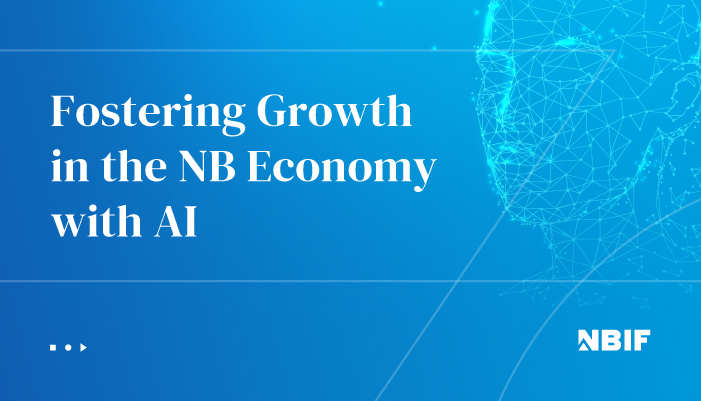- February 8, 2022
- In the News , NBIF News , Uncategorized
- Comments : 0
New Artificial Intelligence (AI) Fund Aims to Foster Growth Throughout the New Brunswick Economy

Angela Pyne
Marketing and Communications Manager
Comprehensive support for innovation promises to vitalize manufacturing and other sectors
Think AI is still the stuff of science fiction? Think again.
If your image of artificial intelligence is a cyborg from Star Wars, then, yes, humanistic robots still belong to the world of fantasy. But other kinds of AI are transforming business and everyday life so rapidly that you may not realize the extent of their impact.
According to the American research firm Gartner, 23% of CIOs are already integrating AI into their organization’s work processes. Within the next three years, the business value of AI is expected to top $5 billion.¹
A new fund, the result of a collaboration between ACOA and NBIF, offers New Brunswick the opportunity to tap into this value and close the technology gap between the province and the rest of Canada.
Launched in late 2021, by the end of 2022, the Artificial Intelligence Fund will inject $3.2 million into innovative projects that bring together New Brunswick researchers and businesses. This investment will boost the profile of AI in the province, help more companies leverage AI, and create a talent pipeline to grow an AI-enabled economy.
WHY FOCUS ON AI?
“AI” serves as an umbrella term for a variety of computing processes and systems that use mathematical logic to learn from their environment and the tasks they perform. Specific forms of AI include data mining, predictive analytics, machine learning, and deep learning.
These technologies are changing the way businesses manage every aspect of their operations, from the supply chain to customer interactions to cyber security. The ROI on AI initiatives can range from around 20% to more than 800%.²
¹ Gartner. (2022). Reinforce Your Artificial Intelligence (AI) Ecosystem. Gartner. https://www.gartner.com/en/information-technology/insights/artificial-intelligence
² Brethenoux, E. (2020). What Is Artificial Intelligence? Seeing Through the Hype and Focusing on Business Value. Gartner. https://emtemp.gcom.cloud/ngw/globalassets/en/doc/documents/730970-what-is-artificial-intelligence-seeing-through-the-hype-and-focusing-on-business-value.pdf
As a cluster of powerful technologies, AI accelerates industry growth and creates well-paid, satisfying career opportunities, across all sectors. In the next decade, AI will play a key role in shaping national and regional economies.
Right now, New Brunswick lags behind the rest of Canada in adopting AI, especially in our manufacturing sector. The new AI Fund is about to change that.
GET READY FOR THE CHRYSALIS TO BURST
For decades, scientists and industry analysts have talked about AI as an “emerging technology.” This potential, which once seemed the stuff of science fiction, has now become real. AI is breaking out of the R&D cocoon and transforming the way we do business, healthcare, education, law, and just about any other area of human activity you can name.
Consider just a few Canadian examples:³
- ROSS is a legal research engine that helps lawyers quickly find data, laws, and precedents. Lawyers pose questions, and ROSS scours databases and analyzes their contents to find the answers.
- Giatec creates smart testing technologies for the construction industry. For example, a contractor can embed sensor technology into poured concrete and get an alert as soon as the concrete is strong enough for the building project to proceed.
- Amii, Alberta’s AI centre of excellence, is partnering with businesses to reduce methane emissions.AI-driven innovation can help oil and gas companies identify opportunities to reduce pollution while making their operations more efficient.
In New Brunswick, businesses have been slow to adopt AI in its larval phase. This is troubling because as AI enters the mainstream, those businesses that don’t incorporate AI will soon fall behind.
As former premier Frank McKenna noted at the recent inauguration of the McKenna Institute, “New Brunswick is well-positioned to emerge as a major centre in our country’s digital ascendency. We just need to be bold and determined enough to seize the tremendous opportunity before us.”
AI AS AN ECONOMIC ENGINE
To seize that opportunity, New Brunswick will need to catch the AI wave that’s sweeping the rest of the world.
Global consulting firms foresee huge economic growth for those who boldly venture into AI. In a 2018 report, McKinsey predicted that more than seven out of 10 businesses would adopt AI by 2030. They estimated the resulting economic gain at $13 trillion USD.⁴ PwC takes an even more optimistic view. They believe that North America’s GDP could increase by as much as 14.5% through AI-driven innovation.⁵
As AI comes into its own, it creates new job opportunities and increased prosperity for regions where those jobs are located. Recent research from Stanford University shows that the demand for AI workers drives economic growth, and that benefits everyone. Two professors associated with the Institute for Human-Centered Artificial Intelligence found that the US cities with the most job ads for AI roles experienced the greatest economic growth. This correlated with overall “improved state of being” for the cities, in terms of physical, social, and financial measures.⁶
With a strong research base in AI, we have the capability to boost our provincial well-being by embracing this new group of technologies. We’ve already seen the positive results that can happen when local companies leverage AI.
Introhive, which we funded back in 2012, serves as a great example. Their AI-powered CRM software has launched them into a global market expected to be worth $96.5B by 2028. Over the past 10 years, they’ve grown into an international company and created more than 300 jobs, most of which are based in Fredericton and Saint John. Last year, they raised $122M in funding from an American venture capital firm. By next year, they plan to grow their team to more than 400.
³ Chowdhury, N., et al. (2020). Pan-Canadian Strategy Impact Assessment Report. Accenture and CIFAR.
THE OPPORTUNITY FOR NEW BRUNSWICK
Since 2015, NBIF has funded 32 AI-related projects, across diverse sectors, including aerospace, healthcare, agriculture, and fisheries. Half of the funding has gone to organizations outside the ICT sector.
That’s the good news: through our post-secondary institutions, we are building provincial bench strength in AI, and our researchers are connecting with industry partners across a range of fields. Nonetheless, New Brunswick trails behind other provinces in terms of both research activity and industry take-up.
⁴ Bughin, J., et al. (2018). Notes from the AI Frontier: Modeling the Impact of AI on the World Economy. McKinsey & Company. https://www.mckinsey.com
⁵ PwC. (2017). Sizing the Prize: What’s the Real Value of AI for Your Business and How Can You Capitalise? PwC. https://www.pwc.com/gx/en/issues/data-and-analytics/publications/artificial-intelligence-study.html
⁶ Burcin, I. (2020). The Link Between Artificial Intelligence Jobs and Well-Being. Stanford University Human-Centered Artificial Intelligence. https://hai.stanford.edu/news/link-between-artificial-intelligence-jobs-and-well-being
This is especially concerning given how heavily we depend on our manufacturing sector. As of 2018, manufacturing contributed 11 percent of New Brunswick’s GDP, almost as great a proportion as in Ontario.⁷ If we were keeping up with global trends, we would be seeing a surge of AI innovation in our provincial factories. Elsewhere, manufacturers are leading the way in adopting Internet of Things technology to automate production, perform quality checks, spot equipment issues, predict maintenance problems, and control the supply chain.
But while the rest of the world has been integrating AI into its manufacturing processes, New Brunswick businesses have so far largely resisted the call to change. A 2021 report for the Atlantic Institute for Policy Research at UNB suggests that a ready supply of inexpensive labour gives employers little reason to look to capital-intensive investments to improve productivity.⁸
This is a dangerously short-sighted view. New Brunswick currently has one of the lowest productivity rates in Canada, and since 2004, productivity in the manufacturing sector has fallen to just 75% of the national average.⁹
The AI Fund aims to reverse this decline and prepare New Brunswick for the AI transformation that is already well underway in other parts of the world.
A STRATEGIC FRAMEWORK FOR GROWTH AT ALL LEVELS
NBIF has developed a strategic funding framework to promote AI innovation throughout our research institutions and to foster AI adoption among a wide range of New Brunswick businesses.
Diversity will be the key to our success. The goal is to encourage research-industry collaboration across various industries and stages of AI maturity. At the same time, we want to start building a pool of highly skilled talent, without whom no sustainable innovation can happen.
Drawing on our experience facilitating applied research in other domains, we have created multi-level, multi-faceted programming:
⁷ In 2018, manufacturing counted for 12% of Ontario’s GDP. Emery, J.C., & Guo, X. (2018). A sector at crossroads: An overview of manufacturing and opportunities for growth in New Brunswick. JDI Roundtable on Manufacturing Competitiveness in New Brunswick Forum. https://www.unb.ca/roundtable/_assets/documents/unb-jdi-round-table-wp-overview-final.pdf
⁸ Sharpe, A. (2021). The Productivity Performance of New Brunswick Manufacturing: A Detailed Analysis, 1997-2019. CSLS Research Report 2021-03. Fredericton: Atlantic Institute for Policy Research, UNB. http://www.csls.ca/reports/csls2021-03.pdf
⁹ Ibid, p.12.
| LEVEL OF AI MATURITY | HOW FUNDING CAN BE USED |
|---|---|
| Keen to build capacity for AI research | Train existing staff, hire students, install complex systems needed for AI research |
| Curious to explore AI solutions to a specific business problem | Collaborate with a researcher to define the problem and identify possible solutions |
| Ready to create a solution | Partner with a researcher to develop a proof of concept or pilot project |
| Already using AI and fully prepared to implement an ongoing solution | Partner with a researcher to develop a proof of concept or pilot project |
The program design is unique in Canada—because New Brunswick is a province with unique potential and special challenges. Our goal is to provide holistic support for businesses of all kinds and sizes, across all sectors of the provincial economy.
As we administer the funding, we will offer other forms of non-financial support as well. As always, we will be available to connect researchers and industry partners with business advisors, other funding agencies, and potential mentors.
We look forward to nurturing a portfolio of AI projects that will break boundaries in terms of what we can achieve in terms of both technology and provincial innovation strategy.



